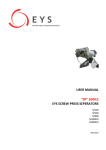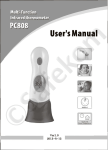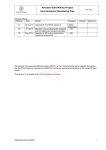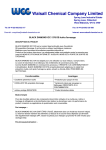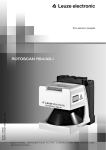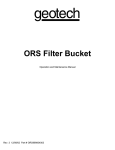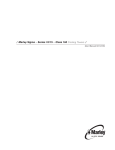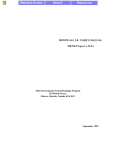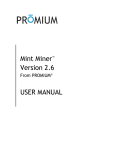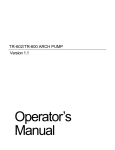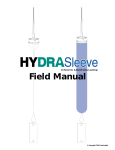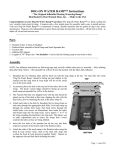Download Dawn Prell, C.P.G., Senior Hydrogeologist, CTI & Associates
Transcript
Environmental Monitoring General Sampling Procedures and Quality Control Objectives Provide a Basic Understanding of: Groundwater Occurrence Collecting Representative Samples Sampling Methods & Equipment Sampling Procedures Record Keeping Best Practices Quality Control March 24, 2014 2 Generalized Groundwater Flow Diagram Typical well installation configuration March 24, 2014 3 Overall Sampling Goal Collect a “Representative Sample” Reflects the actual chemistry in the formation near the well screen. Is not measurably altered by: Well Purging Sample Collection Foreign Material Bottle Handling March 24, 2014 4 Sampling Requires Teamwork Sampling Team: Site Representative Primary Point of Contact Provide current controlling documents Sampler/Project Manager Knows Sampling Requirements Collects Representative Samples Analytical Laboratory Technical Resource March 24, 2014 5 Controlling Documents Site Permit Site-Specific Sampling Plans Regulations Agency Guidance Other Specific Communication Samplers must verify that they are following the most current versions March 24, 2014 6 Controlling Document Content Sampling Points Sampling Order Parameters Methods Procedures Schedule If any of this information is missing – ASK FOR IT! March 24, 2014 7 PURGING & SAMPLING EQUIPMENT March 24, 2014 8 Dedicated vs. Non-Dedicated Dedicated Stays in Well No Decontamination Reduces Sampling Time Preferred for Long-Term Monitoring Non-Dedicated Dedicated Sampling Used in Different Wells Equipment Provides Highest Must be Decontaminated Level of QC but may Increase Costs Increase Sampling Time Potential for Cross Contamination Preferred for Short-Duration Monitoring March 24, 2014 9 Purging and Sampling Equipment Commonly Used Equipment Bladder Pumps Submersible Pumps Dedicated or Disposable Bailers March 24, 2014 10 Purging and Sampling Equipment Purging Equipment can Bias Samples: VOC Loss Turbidity Geochemical Changes Be aware of equipment operations and how it may affect samples. March 24, 2014 11 Bladder Pumps Typically Dedicated to a Well Uses Compressed Air to Constrict a Bladder Interior Bladder fills with Water Compressed Air Squeezes the Bladder Forcing Water out the Discharge Line Flow is Adjustable by Changing the Air Input and Discharge Frequency Favored for long-term monitoring projects and low-flow sampling. March 24, 2014 12 Bladder Pumps Pros: Prevent Air From Contacting Water Minimize Drawdown and Turbidity Wide Range of Flow Adjustment Laminar Flow Into Screen Controlled Discharge Cons: Expensive Compressed Air Source Generally Not Portable Manufacturers now producing smaller more portable devices March 24, 2014 13 Electric Submersible Pumps Dedicated or non-dedicated Electric motor turns impeller Pump lifts water through discharge Water flow through pump cools motor Flow controlled by restricting discharge Newer models use motor control March 24, 2014 14 Electric Submersible Pumps Pros: Fast purge Inexpensive Portable Cons: Flow Adjustment can Build up Heat Stray Voltage Decontamination Potential Overpumping March 24, 2014 15 Bailers Dedicated, non-dedicated or disposal Hollow tube with ball check-valve at base Various material Stainless steel Teflon PVC Cord affixed to top Repeatedly lowered into well Submerged and allowed to fill Raised up to remove water March 24, 2014 16 Bailers Pros: Inexpensive Portable Simple Cons: Slow & Inefficient Aeration in well Turbulence Turbidity Decontamination Handling & Bailer Cord Loss down well March 24, 2014 Always use new bailer cord 17 Purging & Sampling Equipment-Review Various Purge and Sample Methods Available Each has Strengths and Weaknesses Dedicated Systems Preferred Consider: Budget Long-term Needs Site-Specific Conditions Data Quality Requirements March 24, 2014 18 WELL CONDITION INSPECTION March 24, 2014 19 Well Condition Inspection Sampler Responsibilities: Document the condition of each well Recognize when not to sample Communicate issues Samplers are the eyes and ears of the project team. March 24, 2014 20 Well Condition Inspection Identify conditions such as: Missing locks, labels, or weep holes Damaged casing or concrete pad, Inoperable equipment, Excessive vegetation growth Damaged well or pump Evidence of tampering Strong/unusual odors Evidence of surface spills Excessive turbidity Any other maintenance need March 24, 2014 21 Module 2: Groundwater Sampling If a well is not sampled… Complete a Field Information Form (FIF) Reason well not sampled Communications Names Dates Authorizing representative Well Condition Inspection March 24, 2014 23 PURGING & SAMPLING METHODS March 24, 2014 24 Purging & Sampling Methods Three principal methods: Low Flow Traditional Purging Low-Yielding Well Complete Evacuation Minimal Purge March 24, 2014 25 Purging & Sampling Methods Low Flow Sampling Purging volume is based on field parameter stabilization The flow rate must be low enough to: Induce lateral flow from the formation Minimize: Drawdown Turbidity March 24, 2014 26 Field Parameter Stabilization Follow site-specific requirements Measure every 3 to 5 minutes** After water level has stabilized Achieved when all parameters have 3 successive readings meeting the stabilization criteria General stabilization criteria: ** Frequency of pH: ± 0.2 Standard Units measurement may be Conductivity: ± 5% adjusted based on Dissolved Oxygen: ± 10% or 0.2 Mg/L flow. Slow producing wells may need more Turbidity: ± 10% time between readings. Traditional Purging Method Calculate volume of water in the well Purge a minimum of 3 to 5 well volumes Record water levels during purging Do not pump well dry Avoid excessive drawdown - Never expose the pump intake. Attempt to stabilize parameters with minimal drawdown even when doing traditional purge. March 24, 2014 28 Low-Yield Well Methods Slow recharging well where purging less than 0.5 L/min: Dewaters the well, and Field parameters do not stabilize Two sampling approaches Complete evacuation Purge well dry Sample after recovery Minimal purge Dedicated Sampling equipment required Do not purge well Sample water in the well screen area Neither approach is optimal March 24, 2014 29 FIELD MEASUREMENTS March 24, 2014 30 Field Measurements Groundwater Levels Groundwater levels must be recorded: Prior to and during purging With a decontaminated device Accurate to 0.01 foot Referenced to the top-of-casing Be aware of site-specific conditions Extraction wells Record groundwater levels on the same day. March 24, 2014 31 Field Measurements Field Parameters Recorded: During purging - Stabilization When collecting lab samples - Final Common field parameters pH, Temperature, Specific conductance Recommended: Dissolved oxygen, Turbidity, and Oxidation reduction potential (Eh/ORP) Document Field readings are to be taken ASAP Field Book – pH is REQUIRED within 15 Field Information Form minutes… this is far too long. March 24, 2014 32 Field Measurements In-line flow cell: Real-time data Isolates sample from air Provides more consistent data Hand-held instruments: Some parameters may be affected by • • Temperature changes Atmosphere Record as soon as possible Disconnect in-line meters before sample collection March 24, 2014 33 Calibration of Field Meters Calibrate Meters Before Each Event Check Calibration Solution Expiration Date Follow Procedures in the User’s Manual Document Calibration in a Calibration Log or on the Field Information Form • Date • Time • Final Calibration Readings If calibration is not documented, results for entire sample event are subject to challenge. March 24, 2014 34 Unusual or Inconsistent Measurements pH: +/- 1 unit pH: <5 or >9 Specific conductance: +/- 25% Turbidity: Significant change in clarity What you should do: Recalibrate meters Perform additional purging These can alert samplers to calibration or well problem. March 24, 2014 35 Turbidity Goal: <50 NTU NTU 50 – 500: Attempt to reduce to <50 NTU Perform additional purging Reduce purge rate Document on FIF NTU >500: Notify site or Project Manager Do not sample unless authorized Groundwater is not turbid – turbid samples are not representative. Well may be inadequately developed. March 24, 2014 36 Quality Control March 24, 2014 37 Quality Assurance & Quality Control Quality Assurance & Quality Control (QA/QC): Assures sample integrity Avoids sample contamination Documents sample collection Is practiced throughout sampling event March 24, 2014 38 Gloves Powder-Free Latex or Nitrile Gloves Powers can affect samples Change Gloves Upon: Arriving at a new sample location Touching equipment or surfaces Gloves are meant to protect the sample from YOU! March 24, 2014 39 Decontamination Decontaminate: Non-Dedicated Sampling Equipment Use Non-Phosphate Containing Detergent Alconox Liquinox Prior to Each Use Follow Plans for Containment and Disposal Keep distilled or deionized water on hand March 24, 2014 40 Who is using proper QC? March 24, 2014 41 Quality Control Samples Trip Blanks Field Blanks Equipment Blanks Duplicate Samples Detect contaminants introduced in the field, in transit, in bottle preparation, or in the laboratory Confirm analytical results Failure to collect required quality control samples can result in a violation notice March 24, 2014 42 SAMPLE COLLECTION & HANDLING March 24, 2014 43 Filtration Filtration can affect sample chemistry Use in-line cartridge filters Typically 0.45 micron Condition before collecting samples Allow 2 filter volumes to pass March 24, 2014 44 Flow Rate & Bottle Filling After purging -- Reduce flow rate for filling bottles Avoid overfilling and preservative loss Can compromise results Place caps upright on clean surface Minimize agitation/aeration Further reduce flow for filling VOAs If sampling order not specified sample VOCs last so that flow rate may be reduced March 24, 2014 45 Sample Collection and Handling Clearly Label Samples Date/Time Location Personnel Parameters Some labs use barcodes to track samples March 24, 2014 46 Sample Collection and Handling Immediately Place Samples in an Ice-Packed Cooler On hand when sampling Use water ice Blue ice is not as effective Use water ice. Blue or chemical ice is not recommended March 24, 2014 47 Documentation Use Field Information Form (FIF) Complete FIF for Each Sample Location Submit Original FIF to the Laboratory with Samples Record Date Time Sample Location Sample ID Field Measurements Sampler Signature Documents that you sampled the location following proper and required procedures March 24, 2014 48 What If… The sample location is dry, destroyed or inaccessible? Call someone! You are the eyes and ears for the project manager and client. What if you cannot or do not sample a required location? Fill out a Field Information Form anyway. It proves you did not simply forget to sample and it documents the reason why a sample was not collected. Record relevant names and instructions. March 24, 2014 49 Post-Sampling Procedures March 24, 2014 50 Post Sampling - Overview Completing Chain-of-Custody Forms Packaging Coolers Delivering Samples to the Laboratory March 24, 2014 51 Chain-of-Custody (COC) Form Documents the continuous control of the sample from collection to analysis. Remains with the sample until analysis is performed Must be included in the cooler with the samples. Shipping agents (such as FedEx) do not sign the COC. Shipping receipt must be retained as part of the record. A complete COC is required for each cooler. Missing or incomplete COC can result in regulatory or legal challenge of the sample event. March 24, 2014 52 Chain-of-Custody March 24, 2014 53 Sample Coolers Cooler with Custody Seal Samples must be no warmer than 4 degrees Centigrade upon laboratory receipt Cooler With Field Forms and Water Ice March 24, 2014 54 Shipping or Delivery to Laboratory Some laboratories provide shipping Coordinate with the shipper to avoid delays Shippers will not deliver coolers leaking water Coordinate the delivery of short-hold-time samples with the laboratory March 24, 2014 55 Common Errors Chain-of-Custody Incomplete Missing Samples received > 4 degrees Centigrade Broken Sample Containers March 24, 2014 56 Summary Key Actionable Take-Aways You are Part of a Team. Communication is Key Know the Sampling Requirements Inspect and Document Well Conditions Avoid Turbidity and Excessive Drawdown Document all Activities Use Proper Quality Control Throughout Sampling March 24, 2014 57 Thank You Dawn L. Prell, CPG [email protected] March 24, 2014 58


























































